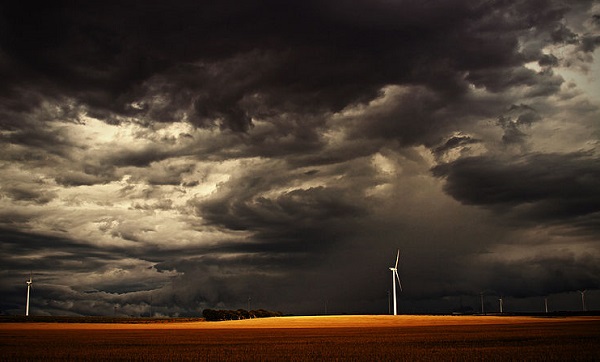If wind farms aren’t already giving anti-wind power activists headaches, Simon Chapman sure is.
The Australian professor of public health, whose New Scientist essay last fall suggested that the scientifically unverified “wind turbine syndrome” is psychogenic, “a ‘communicated’ disease spread by anti-wind interest groups” — and inspired a brilliant bit by Steven Colbert — is back with research that he says backs up his theory.

The basic outline of Chapman’s findings — which, it should be noted, have not yet undergone peer review — is that despite all the noise about wind farm health issues, there aren’t actually a lot of complaints. Out of 32,677 people living within 5 kilometers of 49 wind farms that Chapman studied, a mere 120 have “made formal complaints, appeared in news reports or sent complaining submissions to the government,” Chapman writes.
That’s not a lot, but even more amazing: 82 percent of the complaints came from 2009 on, which Chapman notes is when wind opponents geared up a media campaign focused on alleged health impacts, and 68 percent came from “people living near just five wind farms, each of which have been heavily targeted by wind farm opponents.”
How to account for this?
One explanation, Chapman says, might be that only some people are susceptible, “just like only some people get motion sickness.” The problem with that is, in Western Australia, which “has 13 wind farms (three with large turbines), including some of the longest-running in Australia,” there have been exactly zero complaints.
So the more likely explanation for the health claims, Chapman says, is the “nocebo effect” – the power of the expectation that exposure to wind turbines will cause health problems – linked to fear-mongering by anti-wind farm groups.
To be sure, Chapman is a cheeky contributor to the wind-and-health literature. For instance, he maintains a running list [PDF] of the “symptoms, diseases and aberrant behaviors attributed to wind turbine exposure” (it was up to 216 separate claims as of last week). In the document, Chapman muses, “(Y)ou may ask whether you can recall any account of any threat to humanity which poses a greater threat.”
But while Chapman might come off as more a polemicist than a mere investigator, there is additional new research, from New Zealand, that appears to dovetail nicely with his analysis.
In the New Zealand study, doctoral candidate Fiona Crichton tried to measure the power of suggestion in complaints about exposure to infrasound, the sub-audible sound said to be the cause of many “wind turbine syndrome” cases.
Crichton divided 60 study participants into two groups. One group “watched a DVD presentation which contained television footage, available on the internet, in which people living in the vicinity of wind farms recounted their experience of symptoms that they believed to be caused by wind farms.” The other group “viewed a DVD in which experts put forth the scientific position that exposure to infrasound generated by wind turbines would not cause symptoms.”
Both groups were then exposed to 10 minutes of infrasound – and 10 minutes of what they were told was infrasound, but was actually silence.
According to Crichton, the two groups had remarkably different reactions. The group that saw the DVD that offered the standard scientific view – that infrasound doesn’t cause problems – reported no symptomatic changes compared to a pre-exposure assessment. Not so the other group:
(P)articipants in the high expectancy group reported significant increases from pre-exposure assessment in the number and intensity of symptoms reported during exposure periods. This increase was the same whether exposure was to infrasound or to sham infrasound, indicating that exposure to infrasound did not add to the symptomatic experience.
One reason why wind farm noise might not actually be the cause of health problems was suggested in another recent study by the South Australia Environmental Protection Agency. The agency found that infrasound readings “at rural locations both near to and away from wind farms were no higher than infrasound levels measured at … urban locations.” Not only that, “the results at one of the houses near a wind farm are the lowest infrasound levels measured at any of the 11 locations included in this study.”